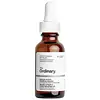What's inside
What's inside
 Key Ingredients
Key Ingredients

 Benefits
Benefits

 Concerns
Concerns

 Ingredients Side-by-side
Ingredients Side-by-side

Salicylic Acid 2%
MaskingWater
Skin ConditioningPropanediol
SolventGlycerin
HumectantPentylene Glycol
Skin ConditioningDicaprylyl Carbonate
EmollientBehenyl Alcohol
EmollientDimethyl Isosorbide
SolventPhysalis Pubescens Fruit Juice
Skin ConditioningAlbatrellus Confluens Extract
HumectantUrea
BufferingYeast Amino Acids
HumectantTrehalose
HumectantTaurine
BufferingInositol
HumectantBetaine
HumectantAllantoin
Skin ConditioningPolylysine
Tocopherol
AntioxidantPullulan
Caprylic/Capric Triglyceride
MaskingLecithin
EmollientPhytosterols
Skin ConditioningCetyl Alcohol
EmollientStearyl Alcohol
EmollientGlyceryl Stearate
EmollientPolyglyceryl-10 Myristate
Skin ConditioningMenthyl Lactate
MaskingXanthan Gum
EmulsifyingSclerotium Gum
Emulsion StabilisingHydrogenated Lecithin
EmulsifyingLeuconostoc/Radish Root Ferment Filtrate
AntimicrobialSilica
AbrasiveDisodium EDTA
Sodium Hydroxide
BufferingCitric Acid
BufferingSalicylic Acid 2%, Water, Propanediol, Glycerin, Pentylene Glycol, Dicaprylyl Carbonate, Behenyl Alcohol, Dimethyl Isosorbide, Physalis Pubescens Fruit Juice, Albatrellus Confluens Extract, Urea, Yeast Amino Acids, Trehalose, Taurine, Inositol, Betaine, Allantoin, Polylysine, Tocopherol, Pullulan, Caprylic/Capric Triglyceride, Lecithin, Phytosterols, Cetyl Alcohol, Stearyl Alcohol, Glyceryl Stearate, Polyglyceryl-10 Myristate, Menthyl Lactate, Xanthan Gum, Sclerotium Gum, Hydrogenated Lecithin, Leuconostoc/Radish Root Ferment Filtrate, Silica, Disodium EDTA, Sodium Hydroxide, Citric Acid
 Reviews
Reviews

Ingredients Explained
These ingredients are found in both products.
Ingredients higher up in an ingredient list are typically present in a larger amount.
This ingredient is an emollient, solvent, and texture enhancer. It is considered a skin-softener by helping the skin prevent moisture loss.
It helps thicken a product's formula and makes it easier to spread by dissolving clumping compounds.
Caprylic Triglyceride is made by combining glycerin with coconut oil, forming a clear liquid.
While there is an assumption Caprylic Triglyceride can clog pores due to it being derived from coconut oil, there is no research supporting this.
Learn more about Caprylic/Capric TriglyceridePentylene glycol is typically used within a product to thicken it. It also adds a smooth, soft, and moisturizing feel to the product. It is naturally found in plants such as sugar beets.
The hydrophilic trait of Pentylene Glycol makes it a humectant. As a humectant, Pentylene Glycol helps draw moisture from the air to your skin. This can help keep your skin hydrated.
This property also makes Pentylene Glycol a great texture enhancer. It can also help thicken or stabilize a product.
Pentylene Glycol also acts as a mild preservative and helps to keep a product microbe-free.
Some people may experience mild eye and skin irritation from Pentylene Glycol. We always recommend speaking with a professional about using this ingredient in your routine.
Pentylene Glycol has a low molecular weight and is part of the 1,2-glycol family.
Learn more about Pentylene GlycolSalicylic Acid (also known as beta hydroxy acid or BHA) is a well-known ingredient for treating skin that struggles with acne and clogged pores. It exfoliates both the skin's surface and deep within the pores to help clear out buildup, control oil, and reduce inflammation.
Unlike AHAs (alpha hydroxy acids), salicylic acid is oil-soluble. This allows it to penetrate into pores which makes it especially effective for treating blackheads and preventing future breakouts.
Salicylic acid is also known for its soothing properties. It has a similar structure to aspirin and can calm inflamed or irritated skin, making it a good option for acne-prone skin that is also sensitive.
Concentrations of 0.5-2% are recognized by the U.S. FDA as an over-the-counter topical acne product.
It can cause irritation and/or dryness if one's skin already has a compromised moisture barrier, so it's best to focus on repairing that before introducing this ingredient into your routine.
While salicylic acid does not increase sun sensitivity, it’s still important to wear sunscreen daily to protect your skin.
If you are looking for the ingredient called BHA or Butylated Hydroxyanisole, click here.
Learn more about Salicylic Acid